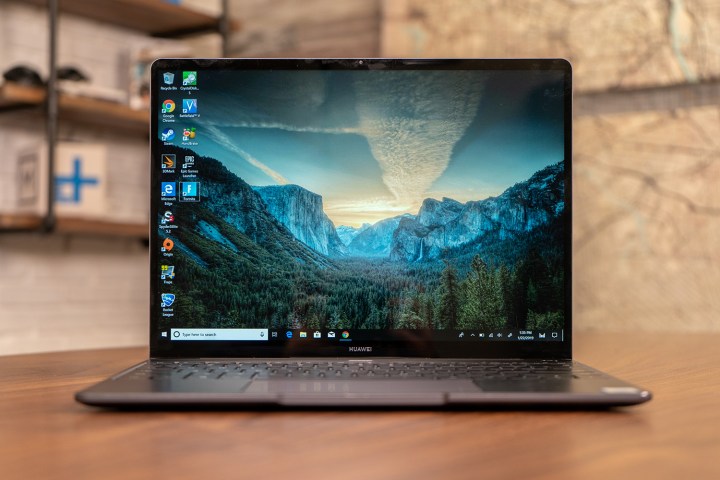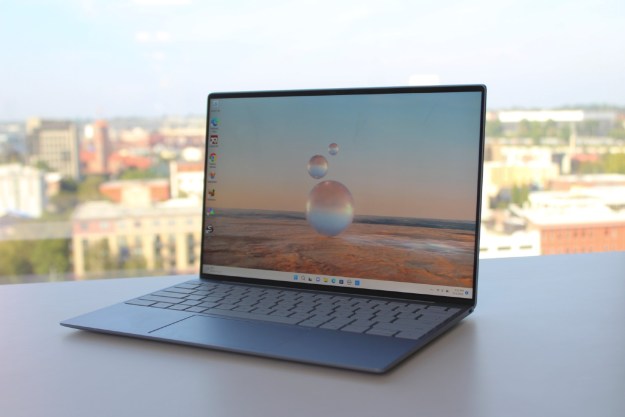
The XPS 13 is our favorite laptop of all time, but with the fresh announcement of the Matebook 13 at CES 2019, Huawei could be giving Dell a run for its money. Both look to be good options if you’re after a slim and light and ultra-premium laptop, so you might be wondering how both stack up against each other.
In this side by side guide, we put up the design, performance, and portability of both laptops against each other. There can only be one winner.
Design

In terms of design, the XPS 13 and the Huawei MateBook 13 are similar. Huawei’s MateBook 13 sports a cool to the touch aluminum finish in either Space Gray and Mystic Silver. Dell, however, goes for a CNC machined aluminum top cover in either rose gold, frost, or platinum silver. The interior of the XPS 13 parts from aluminum and comes with either a carbon fiber palm rest in black or a white woven glass fiber palm rest. If you’re looking to stand out from a crowd, the carbon fiber finish on the XPS 13 might be a bit more stylish than the MateBook 13.
The XPS 13 and the MateBook 13 also measure up well against each other. With a width of 11.26 inches and an overall thickness of 0.59 inches, the MateBook 13 is smaller than the XPS 13 which comes in at 11.9 inches in width, and a thickness of 0.46 inches. Unfortunately, it is a bit heavier, coming in at 2.82 pounds on a model with Integrated graphics, and 2.86 pounds on a model with a discrete GPU. That’s just a bit more than the 2.7-pound weight on the XPS 13. Display bezels are slim on both models, at 4.4mm on the Matebook 13, and 4mm on the XPS 13.
Elsewhere, the keyboards on the MateBook 13 and the XPS 13 are very different. Huawei’s MateBook 13 sports an edge to edge keyboard with large keycaps and 1.2 mm of travel. With a travel of 1.3mm on the XPS 13, we found that its keys have more spring and are not slippery when typing.
You’ll also find the XPS 13 and Huawei Matebook 13 both sport an extra security feature— a Windows Hello fingerprint reader in the power button. With the XPS 13 it is optional, but on the MateBook, it comes as standard to help ensure secure and efficient logins.
Finally, let’s talk webcams. On the XPS 13, Dell has moved it from the middle bottom portion of the screen back up to the top bezel. It is Dell’s smallest webcam ever, and packs in special temporal noise reduction software which can make Skype calls clear. With the MateBook 13, Huawei goes for a simple 1MP camera, which isn’t the best quality compared to 720P on the XPS 13.
Performance

Under the hood, the XPS 13 and the Huawei MateBook 13 share Intel’s latest 8th generation quad-core Whiskey Lake processors. On the Matebook 13, configuration options include a model with the Intel Core i5-8265U processor, with a 256GB NVMe PCIe SSD or a more powerful variant with Core i7-8565U processor, and Nvidia GeForce MX 150 dedicated graphics with a 512 GB SSD.
More CES 2019 coverage
- Our CES 2019 Hub: The latest news, hands-on reviews, and more
- Everything Nvidia announced at CES, including mobile RTX, the RTX 2060, and more
- Dell XPS 13 (2019) review: It was already the best laptop. Now it’s nearly perfect
- Huawei MateBook 13 hands-on review: A MacBook Air for Windows fans
- Samsung’s Notebook Odyssey packs next-gen RTX graphics in a thin frame
Dedicated graphics is the key difference, as you won’t find that extra power on the XPS 13. Fortunately, the XPS 13 does come with the same processor as well as options for the lesser powered Core i3-8145U CPU. Keep in mind that you’re locked to 8GB RAM on the MateBook 13, but can go from anywhere to 4GB or 16GB with the XPS 13. You can have more storage with your XPS 13, as well, with options for either 128GB, 256GB, 512GB, 1TB, or 2TB SSDs.
For those who want to multitask or get more done, the XPS 13 might be more powerful due to its storage and
As for the display, both
Dell’s XPS 13 has the better range of display options. Still, you should be happy with the Huawei MateBook 13’s screen.
Portability

Ending with portability, there is little to worry about for both the MateBook 13 and XPS 13. As we mentioned earlier, both are equally portable and light, and the same can be said for battery life. Huawei quotes a total of 9.6 hours of video playback and 7.3 hours of web browsing on the MateBook 13 model with integrated graphics, and 10 hours on the model with an integrated GPU. The model with the discrete GPU, meanwhile, has the same 9.6 hours of video playback, and 7.2 hours of internet browsing.
In our testing of the XPS 13 model equipped with a
As for ports, Dell is packing in 2 Thunderbolt 3, 1 USB-C, and a microSD card reader in the XPS 13. Huawei takes after Apple and only includes 2 USB-C ports on board the MateBook 13. Still, connectivity is modern on both
Get the XPS 13

At the end of the day, the XPS 13 is the better option over the MateBook 13. With the same options for the same Whiskey Lake processors, battery life that is close to the MateBook 13, and a higher quality webcam, it is hard not to turn down. It also has more configurations available, and in the end, it is definitely the better option for most consumers. Chalk up another victory for Dell.
Editors' Recommendations
- Dell XPS vs. Dell Latitude: here’s how to decide
- Google Drive vs. Dropbox: which is best in 2024?
- Best Dell XPS deals: Save on Dell XPS 13, Dell XPS 15 and Dell XPS 17
- These are the 10 best gaming PCs I’d recommend to anyone
- 9 best laptops of 2024: tested and reviewed


